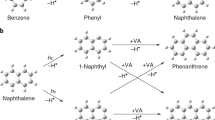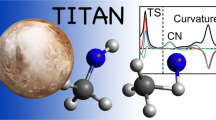Abstract
The unique atmospheric environment on Titan has stimulated great interest in its organic chemistry. Recently1 we proposed that simple organic-nitrogen compounds such as HCN could be efficiently formed by cosmic ray bombardment of a nitrogen-containing atmosphere on Titan. Voyager I has now verified that molecular nitrogen is indeed the major constituent on Titan2–4 and that HCN is also present2. Based on these new data, we now propose that even more complex organic-nitrogen molecules such as ethyl cyanide (CH3CH2CN), vinyl cyanide (CH2CHCN), and cyanoacetylene (HCCCN) may be formed efficiently in the lower atmosphere of Titan, where lower temperatures and higher densities will ensure the efficacy of three-body ion–molecule association reactions. Interestingly, these compounds have been found in several dark interstellar clouds5,6, thus the chemistry suggested here is analogous to that proposed as an explanation of interstellar cyanopolyynes7. The only difference is the role played by three-body association reactions in the dense lower atmosphere of Titan. The mechanism proposed here rests upon a firmer experimental foundation than the analogous radiative association reactions in interstellar clouds.
Similar content being viewed by others
References
Capone, L. A., Dubach, J., Whitten, R. C., Prasad, S. S. & Santhanam, K. Icarus 44, 72–84 (1980).
Hanel, R. et al. Science 212, 192–200 (1981).
Tyler, G. L. et al. Science 212, 192–212 (1981).
Broadfoot, A. L. et al. Science 212, 201–206 (1981).
Kroto, H. W. et al. Astrophys. J. Lett. 219, L133–L137 (1978).
Broten, N. W. et al. Astrophys. J. Lett. 223, L105–L107 (1978).
Mitchell, G. F., Huntress, W. T. & Prasad, S. S. Astrophys. J. 233, 102–108 (1979).
Dubach, J., Whitten, R. C. & Sims, J. S. Planet. Space Sci. 22, 525–536 (1974).
Capone, L. A., Whitten, R. C., Dubach, J., Prasad, S. S. & Huntress, W. T. Icarus 28, 367–378 (1976).
Capone, L. A., Whitten, R. C., Dubach, J. & Prasad, S. S. Astrophys. J. 213, 977–983 (1977).
Capone, L. A., Dubach, J., Whitten, R. C. & Prasad, S. S. Icarus 39, 433–449 (1979).
Huntress, W. T. Astrophys. J. Suppl. 33, 495–514 (1977).
Albritton, D. L. Atom. Data nucl. Data Tabl. 22, 1–101 (1978).
Huntress, W. T., McEwan, M. J., Karpas, Z. & Anicich, V. G. Astrophys. J. Suppl. 44, 481 (1980).
McEwan, M. J. IAU Symp. 87, 299, (1980).
Smith, D. & Adams, N. G. Astrophys. J. Lett. 220, 87–92 (1978).
Handbook of Physics and Chemistry, 43rd edn, p. 2453 (Chemical Rubber Co., Cleveland, 1961).
Author information
Authors and Affiliations
Rights and permissions
About this article
Cite this article
Capone, L., Prasad, S., Huntress, W. et al. Formation of organic molecules on Titan. Nature 293, 45–46 (1981). https://doi.org/10.1038/293045a0
Received:
Accepted:
Issue Date:
DOI: https://doi.org/10.1038/293045a0
- Springer Nature Limited
This article is cited by
-
Rotational excitation of protonated hydrogen cyanide (HCNH+) by He atom at low temperature
Astrophysics and Space Science (2014)
-
H2CN+ · nN2 clustering formation and the atmosphere of Titan
Nature (1982)
-
Organic syntheses from CH4?N2 atmospheres: Implications for Titan
Origins of Life (1982)





